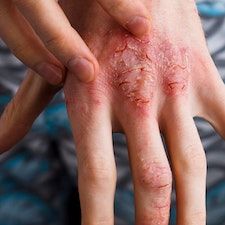Article
CBP-201 Antibody Found to Decrease Severity of Atopic Dermatitis
Author(s):
New late-breaking data supported prior results indicating that all primary and secondary endpoints were reached for the IL-4Rα antibody known as CBP-201 for atopic dermatitis patients.

Patients with atopic dermatitis (AD) treated with next-generation IL-4Rα antibody CBP-201 at 16 weeks achieved greater improvements in Investigator Global Assessment (IGA), Eczema Area and Severity Index (EASI-75 and EASI-90), and Peak Pruritus Numerical Rating Scale (PP-NRS), than placebo, according to new data.1
This late breaking data resulted from a trial in China that followed a larger, global phase 2 trial on CBP-201, which had achieved its primary and secondary endpoints.2,3
The new trial data was featured at the American Academy of Dermatology (AAD) 2023 Annual Meeting in New Orleans, LA. The data was presented at AAD by Chin Lee, MD, MPH, Chief Medical Officer at Connect Biopharma.
The investigators randomized (2 to 1) 255 adults from the primary population with IGA of ≥3, EASI of ≥16, BSA of ≥10%, and PP-NRS of ≥4, to receive CBP-201 or placebo without concomitant topical therapy aside from emollient/rescue medication.
The dosing for the treatment group was 600 mg loading followed by 300 mg after 2 weeks. The investigators’ other criteria for eligibility was having no previous anti-IL-4Rα/IL-13s and having AD inadequately-controlled with topicals.
The investigators reported that median EASI at baseline was 26.9, and 54.5% had an IGA of 4. They wrote that by 16 weeks, greater proportions of study participants in the treatment arm (compared to placebo) achieved IGA 0-1 and had a reduction of ≥2-points (30.3% versus 7.5%).
Additionally, they noted that 62.9% achieved EASI-75 compared to 23.4% in the placebo group. They also added that 35.8% achieved EASI-90 compared to 6.3% and that reductions in PP-NRS were 38.1% compared to 12.3% at 16 weeks.
The investigators added that substantial improvements in efficacy improvements started as early as Week 1, noting that EASI and IGA responses did not end up plateauing.
The proportion of treatment group patients reporting adverse events were 73.5% compared to 72.9% for placebo (for any events), 0.6% versus 3.5% (for serious events), 2.4% versus 5.9% (for severe events), 4.7% versus 3.5% (for conjunctivitis).
Lastly, the investigators noted that reported anaphylaxis was found to be non-serious and unrelated to CBP-201 treatment, adding that a single patient discontinued CBP-201 due to an adverse event.
Overall, the investigators found the trial results to be compatible with the global phase 2 trial.
References
- Lee C, et al. CBP-201, a next-generation IL-4Rα antibody, achieved all primary and secondary efficacy endpoints in the treatment of adults with moderate-to-severe atopic dermatitis (AD): A randomized, double-blind, pivotal trial in China (CBP-201-CN002). Paper presented at: American Academy of Dermatology 2023 Annual Meeting; March 17 – 21. New Orleans, LA. Accessed March 20, 2023.
- Strober B, Feinstein B, Xu J, et al. Efficacy and safety of CBP-201 in adults with moderate-to-severe atopic dermatitis: A phase 2b, randomized, double-blind, placebo-controlled trial (CBP-201-WW001). Poster presented at 18th Maui Derm 2022, Maui, HI, USA.
- Silverberg J, Feinstein B, Guttman-Yassky E, et al. The effect of baseline disease characteristics of efficacy outcomes: Results from a phase 2b, randomized, double-blind, placebo-controlled trial (CBP-201-WW001). Poster presented at 18th Maui Derm 2022, Maui, HI, USA.




